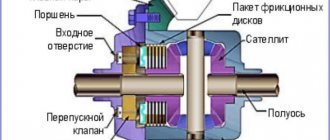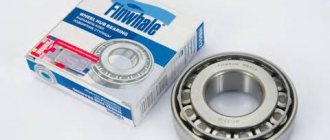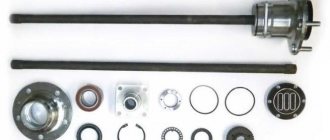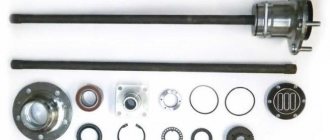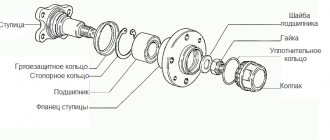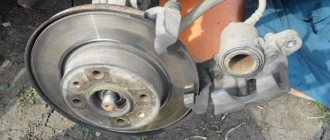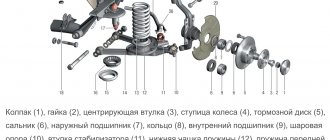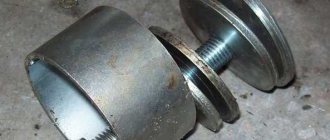In any car, the main driving element of movement is the axle shaft with a bearing. The bearing on the axle shaft ensures equal rotation of the rear and front wheels, and, accordingly, minimizes shock and other mechanical loads on them. The axle bearing is located in the rear axle, behind the brake drum. Like any other mechanical part, a bearing has a certain working life, after which it fails and requires replacement. If the bearing is not replaced, this can lead to serious consequences for the vehicle owner. A deformed bearing can very quickly destroy its cell from excessive friction in the rear axle. Accordingly, the bridge itself will have to be replaced. And this will result in financial losses much more expensive than replacing only one bearing.
Quick navigation
- list of faults
- Selecting a bearing to replace
- Replacing the axle bearing
- Sequence of actions when dismantling the axle shaft
- Removing wheels.
- Removing the brake drum.
- Unscrewing the axle shaft bolts.
- Removing the axle shaft.
- Removing the lock bearing from the axle shaft.
- Installing a new bearing and lock ring on the axle shaft.
- Replacing the axle shaft seal.
- Installing the axle shaft.
Characteristics of the axle bearing for VAZ 2107 classic
Russian-made bearings for VAZ are produced with article numbers 2101-2403080 and 180306. And foreign-made parts have article number 6306 2 RS.
The main characteristics of axle bearings include:
- part type. The bearing belongs to the group of ball, single row;
- radial two-way direction of loads. The value shows which bearing can withstand the load perpendicular to the axes of rotation;
- outer diameter of the bearing – 72 mm;
- internal diameter – 30 mm;
- product width is 19 mm;
- dynamic load capacity, or possible service life - 28100 N;
- static load capacity for residual deformation – 14600 N;
- its weight is 0.35 kg.
List of faults
The total service life of an axle bearing in domestic cars can range from 50 to 150 thousand kilometers. However, the bearing wears out faster when the car is driven on uneven roads, and vice versa, if the car is driven on roads with good coverage, its service life can be significantly longer. Most often, the initial signs of axle bearing wear, which a car enthusiast can notice, appear after the car has covered a mileage of 100 thousand or more km.
Mechanical deformations and material wear of the bearing lead to its malfunction and should be replaced. Without disassembling the axle shaft, it is not possible to determine wear or damage to the part. There are factors by which bearing failure can be determined:
- Noise, hum when turning the wheels.
At the initial stage of bearing wear, a hum or metallic grinding noise can be heard when the wheels are turned. These sounds may increase or decrease depending on the speed of the car. This factor is not critical when the car is moving. But at the same time, you should not put off replacing the bearing for too long.
- Drum heating.
When moving, a faulty bearing increases the friction force of the axle shaft and flange, and the excessively generated heat is transferred to the central part of the drum. This factor can be noticed if you drive the car a little and then touch the central part of the drum with the back of your hand.
- The grinding of wheels.
After a hum appears during the turning movements of the wheels and the drum heats up, and the grinding of the wheels also becomes audible, then it’s time to sound the alarm. Most likely, the axle bearing has failed or is completely destroyed. Given the combination of these three factors, you should not continue further movement, but immediately look for a service center to replace the bearing. Otherwise, it will lead to irreparable consequences.
- The appearance of a gap on the wheels.
If the wheel has a gap or play, this may indicate a faulty axle bearing. To detect this, you need to shake the wheel using your hands and a jack. If the bearing is normal, the wheel will not wobble.
Article: 2101-2403084, additional articles: 21010240308400
Order code: 000486
- Buy with this product
- show more
- Passenger cars / VAZ / VAZ-21011 drawing
- » href=»/catalog/vaz-3/legkovye_avtomobili-30/vaz_2101-3/most_zadniiy_i_poluosi-133/#part3012″>Closing ring bearing Rear axle / Rear axle and axle shafts
- Passenger cars / VAZ / VAZ-21031 drawing
- » href=»/catalog/vaz-3/legkovye_avtomobili-30/vaz_2103-106/most_zadniiy_i_poluosi-103/#part11147″>Closing ring bearing Rear axle / Rear axle and axle shafts
- Passenger cars / VAZ / VAZ-21051 drawing
- » href=»/catalog/vaz-3/legkovye_avtomobili-30/vaz_2105-6/most_zadniiy_i_poluosi-108/#part17684″>Closing ring bearing Rear axle / Rear axle and axle shafts
- Passenger cars / VAZ / VAZ-21071 drawing
- » href=»/catalog/vaz-3/legkovye_avtomobili-30/vaz_2107-8/most_zadniiy_i_poluosi-154/#part25080″>Closing ring bearing Rear axle / Rear axle and axle shafts
- Passenger cars / VAZ / VAZ-21021 drawing
- » href=»/catalog/vaz-3/legkovye_avtomobili-30/vaz_2102-4/most_zadniiy_i_poluosi-133/#part7496″>Closing ring bearing Rear axle / Rear axle and axle shafts
- Passenger cars / VAZ / VAZ-21041 drawing
- » href=»/catalog/vaz-3/legkovye_avtomobili-30/vaz_2104-5/most_zadniiy_i_poluosi-108/#part14578″>Closing ring bearing Rear axle / Rear axle and axle shafts
- Passenger cars / VAZ / VAZ-21061 drawing
- » href=»/catalog/vaz-3/legkovye_avtomobili-30/vaz_2106-7/most_zadniiy_i_poluosi-113/#part20815″>Closing ring bearing Rear axle / Rear axle and axle shafts
There are no reviews for this product yet.
Today, the next article in the series “Crystal VAZs or typical breakdowns of domestic cars” is dedicated to the “classics”: VAZ-2101, 2103, 2104, 2104, 2105, 2106 and 2107. These cars have been driving along our roads for decades and, despite Despite all the shortcomings that we will talk about, their popularity is still high.
Selecting a bearing to replace
The bearing for a VAZ is a single piece and cannot be repaired if completely worn out. Even if you try to lubricate it, it still won’t last long. During the operation of the car, it will be destroyed.
Since Russian-made bearings fully comply with regulatory documentation and are manufactured in accordance with GOST, preference should be given to them when purchasing. Russian bearings are fully intended for vehicle movement on Russian roads, so their wear life will be more optimal for the owner.
Bearings are produced at factories in Vologda and Samara. The average cost of one unit is about 250 rubles. Do not forget that along with the bearing you must also purchase a locking ring and an oil seal. Their cost varies 220 rubles and 25 rubles, respectively.
Experienced car enthusiasts advise changing the bearing head right away, since they have approximately the same mileage and if one fails, then most likely in a few days the second one will also fail.
Replacing the axle bearing
It is quite difficult to replace a bearing yourself, but it is possible. This process is very labor-intensive and time-consuming. To replace the bearing you will need about two hours of free time. The most important point in this process will be the availability of all the necessary tools to carry out the replacement efficiently:
- Jack.
- Devices for strengthening the raised body. (can be replaced with a removed wheel)
- Balloon wrench.
- Wheel stops.
- Reverse hammer. (can replace removed brake drum)
- Keys for 8 and 12.
- Socket or socket wrench size 17.
- Vise, workbench. (working with a vice is safer)
- Slotted screwdriver.
- Blowtorch or gas torch
- Bulgarian.
- Hammer and chisel
- Pliers.
- Grease and rags.
What you need for work
The diagnosis is made and the owner of the “seven” decides to change the part himself. What is needed to carry out the work correctly?
- Hammer.
- Chisel.
- Electric angle grinder, popularly called an angle grinder.
- 80 or slightly less centimeters of pipe with an internal diameter of 32 millimeters.
- Socket head No. 32 and wrench No. 17.
- Open-end wrench No. 10.
- Engine oil: motor or transmission oil, 100 grams.
- Lithium grease.
- An anvil or an object that can replace it.
- Blowtorch or other similar type of torch.
- New working bearing.
- Locking bushing and a set of seals for the axle shaft.
- Jack.
- Stop shoes.
- Mount.
- Rags.
The design solution of the classic Zhiguli models is simple. It will not be difficult to understand the system. Take the instruction manual, it clearly describes what is where. In order to change a part, it is not at all necessary to stand on an inspection hole or lift the car with a truck crane. Although these devices can significantly facilitate and speed up the operation.
Sequence of actions when dismantling the axle shaft
To dismantle the axle shaft and get to the bearing, you must perform the following steps in strict sequence:
- For convenience, the vehicle is placed on a flat surface.
- Secure all the wheels of the car with stops or other devices.
- The wheel bolts must be turned with a wheel wrench until they are slightly loosened before removal.
Removing wheels.
- Use a wheel wrench to completely unscrew all the bolts on the wheels.
- Use a jack to raise the car body and secure the lifting with supports.
Removing the brake drum.
- Remove the two drum guides using a 8 or 12 wrench.
- Remove the drum itself. If necessary, assist removal with hammer blows. To avoid deformation, place a wooden stand. An alternative way to remove the brake drum: start the car, put it in third gear, spin the engine to 3 thousand rpm and sharply press the brake. Repeat acceleration and deceleration several times, after which the drum can be easily removed
Unscrewing the axle shaft bolts.
Little by little, without using much effort, turn the axle shaft to get to the nuts. The axle shaft mounting bolts can be unscrewed using a 17mm socket wrench. They are used to loosen and remove 4 fastening nuts, which are closed with a special flange.
Removing the axle shaft.
We turn the removed brake drum over (with the inner side facing us), screw it to the axle shaft with a couple of bolts and sharply pull it towards ourselves, thus pulling out the axle shaft. (Instead of the brake drum, you can use a previously removed wheel)
But if you have a reverse hammer, you can remove the axle shaft with it. The hammer is attached to the axle shaft with wheel bolts. If you sharply place a load in the opposite direction, then due to the appearance of a shock load, the axle shaft begins to move towards the load. Thus, the axle shaft is removed. Then unscrew the hammer from the axle shaft and remove the rubber sealing ring.
Removing the lock bearing from the axle shaft.
The axle shaft is clamped in a vice and a small cut is made using a grinder on the outside of the locking ring.
The clamped locking ring is finally split by alternately striking the cut from the grinder with a hammer or chisel. Thus, the bearing is removed from the axle shaft. The axle shaft is checked after removing the bearing for surface deformations or chips or other damage. If there are any, then the axle shaft will have to be changed.
Installing a new bearing and lock ring on the axle shaft.
- The boot is pulled out of the new bearing.
- The bearing is then lubricated with grease or grease.
- Reinstall the boot.
- Lubricate the axle shaft with grease.
- Place the bearing on the axle shaft so that the boot is turned towards the oil deflector.
- Use a hammer to drive the bearing into the cell. To make it easier, you can use a piece of pipe. Place one end of it against the axle shaft with the bearing, and hit the other end with a hammer.
- The locking ring is heated with a blowtorch until a white coating appears on it.
- Using pliers, place the ring on the axle shaft of the VAZ 2107.
- Install the ring hermetically tightly to the bearing.
- Cool the lock ring by pouring engine oil onto it.
Replacing the axle shaft seal.
The oil seal to be replaced must be pulled out of its cell. To do this, lift its body with a screwdriver and remove the oil seal. The cell under the oil seal is wiped from the accumulation of dirt and dust, and grease is applied. The new oil seal is inserted into the seat with a spring to the beam. Use a special bushing and a hammer to drive the oil seal so that it is pressed tightly.
Installing the axle shaft.
Installation of the axle shaft is carried out in the reverse order from its removal. Put on the rubber sealing ring and bolt the axle shaft. Use small rotational movements to put it in place.
After installing the axle shaft, it is necessary to check it for the formation of gaps. They shouldn't exist. To do this, the wheels are rotated in all directions. If there are no gaps and no extraneous sounds appear during rotation, then the installation of the bearing and axle shaft was done correctly and correctly.
If necessary, replace the bearing on the second axle shaft in the same manner. Also, when carrying out these actions, you can immediately replace the brake pads and check the presence and level of lubricant in the axle housing.
Removing the locking ring
Removing and installing the axle bearing lock ring must only be done using a hydraulic press.
1. Use the half rings of tool A.74108/R to surround the bearing and install the half shaft vertically so that the half rings rest on the thrust ring.
2. Place axle shaft 2 under the press and apply gradually increasing force to the splined end of the axle shaft until the bearing lock ring is removed (1 - tool A.74108/R).
Do not reuse the axle bearing lock ring, but replace it with a new one.
3. Check whether the seating surface of the axle shaft has any marks or damage; if necessary, replace the axle shaft with a new one.
